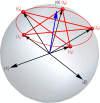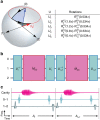Contextuality without nonlocality in a superconducting quantum system
- PMID: 27698351
- PMCID: PMC5059491
- DOI: 10.1038/ncomms12930
Contextuality without nonlocality in a superconducting quantum system
Abstract
Classical realism demands that system properties exist independently of whether they are measured, while noncontextuality demands that the results of measurements do not depend on what other measurements are performed in conjunction with them. The Bell-Kochen-Specker theorem states that noncontextual realism cannot reproduce the measurement statistics of a single three-level quantum system (qutrit). Noncontextual realistic models may thus be tested using a single qutrit without relying on the notion of quantum entanglement in contrast to Bell inequality tests. It is challenging to refute such models experimentally, since imperfections may introduce loopholes that enable a realist interpretation. Here we use a superconducting qutrit with deterministic, binary-outcome readouts to violate a noncontextuality inequality while addressing the detection, individual-existence and compatibility loopholes. This evidence of state-dependent contextuality also demonstrates the fitness of superconducting quantum circuits for fault-tolerant quantum computation in surface-code architectures, currently the most promising route to scalable quantum computing.
Figures


 and
and  are close to identical, not allowing the measurement to distinguish between the two states.
are close to identical, not allowing the measurement to distinguish between the two states.
 , where ϕ is a rotation of angle about the axis
, where ϕ is a rotation of angle about the axis  in the qutrit subspace spanned by {|i〉, |i+1〉}. The rightmost pulse in a product is applied first in time. The trajectory of the state under transformation U4 is shown as an example. (b) The measurement protocol includes two sequential projecting measurements M|0〉 onto the ground state with unitary transformations before and after each measurement. The unitaries rotate the measurement axis into one of the states of the KCBS pentagram. (c) The actual experimental sequence for each pair of measurements. Measurement of the M|0〉 observable is implemented with a cavity probe signal and the qutrit rotations
in the qutrit subspace spanned by {|i〉, |i+1〉}. The rightmost pulse in a product is applied first in time. The trajectory of the state under transformation U4 is shown as an example. (b) The measurement protocol includes two sequential projecting measurements M|0〉 onto the ground state with unitary transformations before and after each measurement. The unitaries rotate the measurement axis into one of the states of the KCBS pentagram. (c) The actual experimental sequence for each pair of measurements. Measurement of the M|0〉 observable is implemented with a cavity probe signal and the qutrit rotations  are constructed with microwave pulses applied at the qutrit transition frequencies.
are constructed with microwave pulses applied at the qutrit transition frequencies.References
-
- Bell J. S. On the Einstein-Podolsky-Rosen paradox. Physics 1, 195–200 (1964).
-
- Bell J. S. On the problem of hidden variables in quantum mechanics. Rev. Mod. Phys. 38, 447–452 (1966).
-
- Kochen S. & Specker E. P. The problem of hidden variables in quantum mechanics. J. Math. Mech 17, 59–87 (1967).
-
- Klyachko A. A., Can M. A., Binicioğlu S. & Shumovsky A. S. Simple test for hidden variables in spin-1 systems. Phys. Rev. Lett. 101, 020403 (2008). - PubMed
-
- Cabello A. Experimentally testable state independent quantum contextuality. Phys. Rev. Lett. 101, 210401 (2008). - PubMed
Publication types
LinkOut - more resources
Full Text Sources
Other Literature Sources

